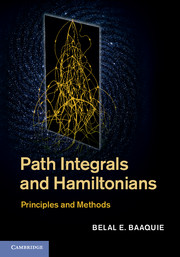Book contents
- Frontmatter
- Dedication
- Contents
- Preface
- Acknowledgements
- 1 Synopsis
- Part one Fundamental principles
- Part two Stochastic processes
- Part three discrete degrees of freedom
- Part four Quadratic path integrals
- 11 simple harmonic oscillator
- 12 Gaussian path integrals
- Part five Action with acceleration
- Part six Nonlinear path integrals
- References
- Index
11 - simple harmonic oscillator
from Part four - Quadratic path integrals
Published online by Cambridge University Press: 05 April 2014
- Frontmatter
- Dedication
- Contents
- Preface
- Acknowledgements
- 1 Synopsis
- Part one Fundamental principles
- Part two Stochastic processes
- Part three discrete degrees of freedom
- Part four Quadratic path integrals
- 11 simple harmonic oscillator
- 12 Gaussian path integrals
- Part five Action with acceleration
- Part six Nonlinear path integrals
- References
- Index
Summary
A simple harmonic oscillator, or oscillator in short, is one of the most important systems in physics as well as in quantum mechanics. The path integral and Hamiltonian of a simple harmonic oscillator are leading exemplars for the description of a wide class of physical systems. An oscillator is a theoretical model of great utility, primarily due to its simplicity that allows for the exact derivation of many results.
The simple harmonic oscillator can be generalized to the case of infinitely many oscillators, and is also the starting point for analysis of many nonlinear quantum systems.
Path integrals for the simple harmonic oscillator are all based on Gaussian integration, which has been discussed in Section 7.2. The harmonic oscillator is described by Gaussian path integrals, and is a bedrock of the general theory of path integration. Moreover, all perturbation expansions of nonlinear path integrals about the oscillator path integral, which includes the semi-classical expansion, are based on results of Gaussian integration.
The properties of the harmonic oscillator are analyzed in the coordinate space representation, and its path integral as well as its correlation functions are analyzed. All formulas and derivations are for Euclidean time.
In Sections 11.1 and 11.2 the Hamiltonian and state space of the oscillator are studied and the correlator is derived using state space methods. In Section 11.2 the infinite time oscillator is introduced and in Sections 11.3–11.5 the path integral for the oscillator is evaluated.
Information
- Type
- Chapter
- Information
- Path Integrals and HamiltoniansPrinciples and Methods, pp. 225 - 250Publisher: Cambridge University PressPrint publication year: 2014
